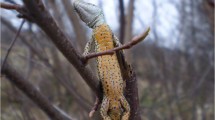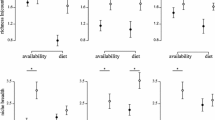Abstract
Optimal foraging theory predicts less diverse predator diets with a greater availability of preferred prey. This narrow diet niche should then be dominated by preferred prey, with implications for predator–prey dynamics and prey population ecology. We investigated lion (Panthera leo) diets in Hluhluwe–iMfolozi Park (HiP), South Africa, to assess whether lions in a site with a high density of preferred prey (prey species weighing 92–632 kg as estimated from a published meta-analysis) have a narrow diet, consisting primarily of preferred prey. HiP is a useful study site to investigate this prediction because it is a productive landscape (with a high density of prey) where lion-preferred prey constitutes up to 33% of the prey available to lions. Furthermore, to investigate whether lions in HiP exhibit sex-specific diets as documented in other southern African populations, we estimated male and female lion diets separately. We were specifically interested in testing whether traditional approaches of estimating lion diets at the population level mask sex-specific predation patterns, with possible implications for management of lions in small to medium-sized fenced reserves. Lions in HiP preferred larger prey species (63–684 kg) and had diets with a larger proportion of preferred prey than reported in an African-wide meta-analysis. However, despite the high density of preferred prey species, 36% of lion diets still consisted of typically non-preferred species such as nyala (Tragelaphus angasii). This finding suggests that lions in HiP maintain a degree of opportunism even when preferred prey are abundant. Therefore, abundant, non-preferred prey are likely to be an important resource for lion populations. Sex-specific differences in lion diets were evident in HiP, suggesting that estimation of lion resource use and carrying capacity should consider opportunistic hunting and sex-specific differences in lion diets.



Similar content being viewed by others
References
Bissett C, Bernard RTF, Parker DM (2012) The response of lions (Panthera leo) to changes in prey abundance on an enclosed reserve in South Africa. Acta Theriol 57:225–231. https://doi.org/10.1007/s13364-011-0071-8
Buys D, Keogh HJ (1984) Notes on the microstructure of hair of the Orycteropodidae, Elephantidae, Equidae, Suidae and Giraffidae. S Afr J Wildl Res 14:111–119
Clements HS, Tambling CJ, Hayward MW, Kerley GIH (2014) An objective approach to determining the weight ranges of prey preferred by and accessible to the five large African carnivores. PLoS One 9:e101054. https://doi.org/10.1371/journal.pone.0101054
Cromsigt JPGM, Prins HHT, Olff H (2009) Habitat heterogeneity as a driver of ungulate diversity and distribution patterns: interaction of body mass and digestive strategy. Divers Distrib 15:513–522. https://doi.org/10.1111/j.1472-4642.2008.00554.x
Cromsigt JPGM, Archibald S, Owen-Smith N (2017) Conserving Africa’s mega-diversity in the Anthropocene: the Hluhluwe-iMfolozi Park story. Cambridge University Press, Cambridge
Davidson Z, Valeix M, Van Kesteren F, Loveridge AJ, Hunt JE, Murindagomo F, Macdonald DW (2013) Seasonal diet and prey preference of the African lion in a waterhole-driven semi-arid savanna. PLoS One 8:e55182. https://doi.org/10.1371/journal.pone.0055182
Davies AB, Tambling CJ, Kerley GIH, Asner GP (2016) Effects of vegetation structure on the location of lion kill sites in African thicket. PLoS One 11:e0149098. https://doi.org/10.1371/journal.pone.0149098
Douglas AM (1989) A new method of cross-sectioning hair of larger mammals. S Afr J Wildl Res 19:73–76
Druce DJ, Druce H, te Beest M, Cromsigt JPGM, Janse van Rensburg S (2017) Elephant management in the Hluhluwe-iMfolozi Park. In: Cromsigt JPGM, Archibald S, Owen-Smith N (eds) Conserving Africa’s mega-diversity in the Anthropocene: the Hluhluwe-iMfolozi Park story. Cambridge University Press, Cambridge, pp 336–357
Funston PJ, Mills MGL (2006) The influence of lion predation on the population dynamics of common large ungulates in the Kruger National Park. S Afr J Wildl Res 36:9–22
Funston PJ, Mills MGL, Biggs HC, Richardson PRK (1998) Hunting by male lions: ecological influences and socioecological implications. Anim Behav 56:1333–1345. https://doi.org/10.1006/anbe.1998.0884
Hayward MW (2011) Scarcity in the prey community yields anti-predator benefits. Acta Oecol 37:314–320. https://doi.org/10.1016/j.actao.2011.03.003
Hayward MW, Kerley GIH (2005) Prey preferences of the lion (Panthera leo). J Zool 267:309–322. https://doi.org/10.1017/S0952836905007508
Hayward MW, O’Brien J, Kerley GIH (2007) Carrying capacity of large African predators: predictions and tests. Biol Conserv 139:219–229. https://doi.org/10.1016/j.biocon.2007.06.018
Howison RA, Olff H, Owen-Smith N, Cromsigt JPGM, Archibald S (2017) The abiotic template for the Hluhluwe-iMfolozi Park’s landscape heterogeneity. In: Cromsigt JPGM, Archibald S, Owen-Smith N (eds) Conserving Africa’s mega-diversity in the Anthropocene: the Hluhluwe-iMfolozi Park story. Cambridge University Press, Cambridge, pp 33–55
Jacobs J (1974) Quantitative measurement of food selection. Oecologia 14:413–417. https://doi.org/10.1007/BF00384581
Keogh HJ (1983) A photographic reference system of the microstructure of the hair of southern African bovids. S Afr J Wildl Res 13:89–131
Levins R (1968) The theory of the niche. In: Evolution in changing environments: some theoretical explorations. Princeton University Press, Princeton, pp 39–65
Linklater WL, Shrader AM (2017) Rhino management challenges: spatial and social ecology for habitat and population management. In: Cromsigt JPGM, Archibald S, Owen-Smith N (eds) Conserving Africa’s mega-diversity in the Anthropocene: the Hluhluwe-iMfolozi Park story. Cambridge University Press, Cambridge, pp 265–285
Loarie SR, Tambling CJ, Asner GP (2013) Lion hunting behaviour and vegetation structure in an African savanna. Anim Behav 85:899–906. https://doi.org/10.1016/j.anbehav.2013.01.018
Loveridge AJ, Searle AW, Murindagomo F, Macdonald DW (2007) The impact of sport-hunting on the population dynamics of an African lion population in a protected area. Biol Conserv 134:548–558. https://doi.org/10.1016/j.biocon.2006.09.010
Macarthur RH, Pianka ER (1966) On optimal use of a patchy environment. Am Nat 100:603–609. https://doi.org/10.1086/282454
Miller SM, Bissett C, Burger A, Courtenay B, Dickerson T, Druce DJ, Ferreira S, Funston PJ, Hofmeyr D, Kilian PJ, Matthews W, Naylor S, Parker DM, Slotow R, Toft M, Zimmermann D (2013) Management of reintroduced lions in small, fenced reserves in South Africa: an assessment and guidelines. S Afr J Wildl Res 43:138–154. https://doi.org/10.3957/056.043.0202
Miller SM, Tambling CJ, Funston PJ (2015) GrowLS: lion (Panthera leo) population growth simulation for small reserve management planning. Afr J Wildl Res 45:169–177. https://doi.org/10.3957/056.045.0169
Mills MGL, Biggs HC, Whyte IJ (1995) The relationship between rainfall, lion predation and population trends in African herbivores. Wildl Res 22:75–87. https://doi.org/10.1071/WR9950075
Nakagawa S, Santos ESA (2012) Methodological issues and advantages in biological meta-analysis. Evol Ecol 26:1253–1274. https://doi.org/10.1007/s10682-012-9555-5
Owen-Smith N, Mills MGL (2008) Predator-prey size relationships in an African large-mammal food web. J Anim Ecol 77:173–183. https://doi.org/10.1111/j.1365-2656.2007.01314.x
Perrin MR, Campbell BS (1980) Key to the mammals of the Andries Vosloo Kudu Reserve (Eastern Cape), based on their hair morphology, for use in predator scat analysis. S Afr J Wildl Res 10:1–14
Power RJ (2002) Prey selection of lions Panthera leo in a small, enclosed reserve. Koedoe 45:67–75. https://doi.org/10.4102/koedoe.v45i2.32
Pyke GH, Pulliam HR, Charnov EL (1977) Optimal foraging: a selective review of theory and tests. Q Rev Biol 52:137–154. https://doi.org/10.1086/409852
R Core Team (2016) R: A language and environment for statistical computing. https://www.R-project.org/
le Roux E, Clinning G, Druce DJ, Owen-Smith N, Graf JA, Cromsig JPGM (2017) Temporal changes in the large herbivore fauna of Hluhluwe-iMfolozi Park. In: Cromsigt JPGM, Archibald S, Owen-Smith N (eds) Conserving Africa’s mega-diversity in the Anthropocene: the Hluhluwe-iMfolozi Park story. Cambridge University Press, Cambridge, pp 80–110
Scheel D (1993) Profitability, encounter rates, and prey choice of African lions. Behav Ecol 4:90–97. https://doi.org/10.1093/beheco/4.1.90
Schoener TW (1971) Theory of feeding strategies. Annu Rev Ecol Syst 2:369–404. https://doi.org/10.1146/annurev.es.02.110171.002101
Sidorovich VE, Tikhomirova LL, Jędrzejewska B (2003) Wolf Canis lupus numbers, diet and damage to livestock in relation to hunting and ungulate abundance in northeastern Belarus during 1990–2000. Wildl Biol 9:103–111. https://doi.org/10.2981/wlb.2003.032
Somers MJ, Becker P, Druce DJ, Graf J, Gunther MS, Marneweck D, Trinkel M, Moleón M, Hayward MW (2017) Reassembly of the large predator guild into Hluhluwe-iMfolozi Park. In: Cromsigt JPGM, Archibald S, Owen-Smith N (eds) Conserving Africa’s mega-diversity in the Anthropocene: the Hluhluwe-iMfolozi Park story. Cambridge University Press, Cambridge, pp 286–310
Tambling CJ, Cameron EZ, Du Toit JT, Getz WM (2010) Methods for locating African lion kills using global positioning system movement data. J Wildl Manag 74:549–556. https://doi.org/10.2193/2009-010
Tambling CJ, Laurence SD, Bellan SE, Cameron EZ, Du Toit JT, Getz WM (2012) Estimating carnivoran diets using a combination of carcass observations and scats from GPS clusters. J Zool 286:102–109. https://doi.org/10.1111/j.1469-7998.2011.00856.x
Van De Ven TMFN, Tambling CJ, Kerley GIH (2013) Seasonal diet of black-backed jackal in the Eastern Karoo, South Africa. J Arid Environ 99:23–27. https://doi.org/10.1016/j.jaridenv.2013.09.003
Acknowledgements
We thank Ezemvelo KwaZulu–Natal Wildlife (EKZNW) for permission to work in Hluhluwe–iMfolozi Park and for providing the lion movement data (project permit number: E/5118/02). We thank Drs Dave Cooper and Birgit Eggers, the EKZNW veterinarians, for assistance in immobilising and sampling the lions.
Funding
This research was supported by the Centre for African Conservation Ecology, the Carnegie Institution for Science, the Andrew Mellon Foundation, the Claude Leon Foundation scholarship to E. Le Roux, the Swedish University of Agricultural Sciences, and a South African National Research Foundation Honours scholarship to T. Barnardo. Eleven of the telemetry collars and the field work associated with this project were funded by a grant from the Andrew Mellon Foundation to G.P. Asner. The remaining three telemetry collars were funded by a Marie Curie Grant held by J. Cromsigt (grant no. PCIG10-GA-2011-304128).
Author information
Authors and Affiliations
Corresponding author
Ethics declarations
All applicable international, national, and/or institutional guidelines for the care and use of animals were followed.
Conflict of interest
The authors declare that they have no conflict of interest.
Additional information
Communicated by: Rafał Kowalczyk
Publisher’s note
Springer Nature remains neutral with regard to jurisdictional claims in published maps and institutional affiliations.
Rights and permissions
About this article
Cite this article
Barnardo, T., Tambling, C.J., Davies, A.B. et al. Opportunistic feeding by lions: non-preferred prey comprise an important part of lion diets in a habitat where preferred prey are abundant. Mamm Res 65, 235–243 (2020). https://doi.org/10.1007/s13364-020-00481-3
Received:
Accepted:
Published:
Issue Date:
DOI: https://doi.org/10.1007/s13364-020-00481-3




